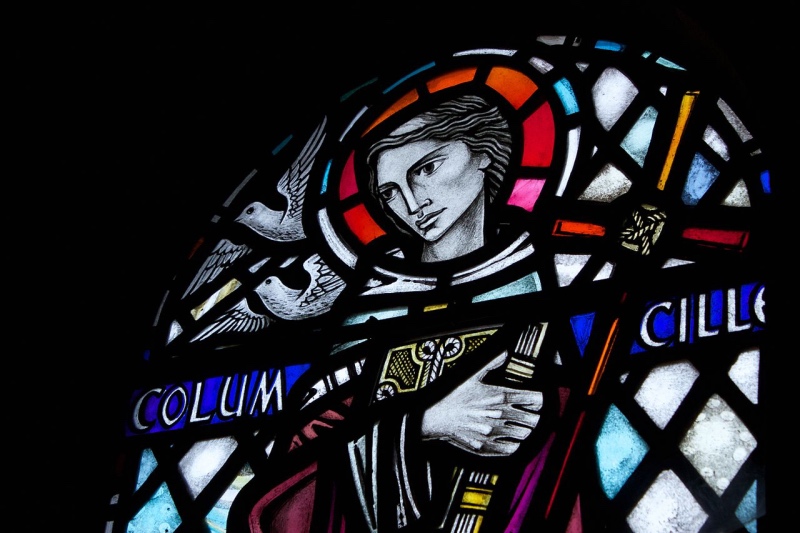
DAVID ADAMS takes a look at the life of St Columba, one of the patron saints of Ireland…
A key figure in the introduction of Christianity to the British Isles, St Columba was a sixth century Irish missionary who founded an important abbey on the Scottish island of Iona.
Said to have been born in 521AD in Gartan in County Donegal in Ireland, Columba (in Gaelic, Colmcille, although it has been speculated that was a name he was given as a Christian; his original name may have been something like Crimthann) is believed to have been of royal blood, the grandson of the Irish King Niall. He entered the monastic school of Movilla at a young age and trained under St Finnian.

A stained glass window depicting St Columba in Iona Abbey. PICTURE: Brian Gratwicke (licensed under CC BY 2.0).
At the age of 20, he travelled south to Leinster and apparently trained under a bard before entering the famous monastery of Clonard. There he became one of 12 students of St Finnian, who became known as the ’12 Apostles of Ireland’. Made a monk, he was later ordained a priest.
Tradition holds that in the 540s he returned to Ulster in Ireland’s north and there founded a number of important monasteries including at Derry, Kells and Swords.
He also apparently planned a pilgrimage to Rome and Jerusalem but failed to get further than Tours in France returning to Ireland, however, with a copy of the Gospels that had lain on the breast of St Martin for 100 years and depositing them at the Derry monastery.
The story goes that around 560, he fell out with St Finnian over a holy book which led to a pitched battle in north-western Ireland during which many died and it was in a need to expiate his offence that Columba resolved to go into exile and win as many souls for Christ as had died in the battle.
Taking 12 companions, in 563 he is believed to have travelled to Scotland, landing first on the Kintyre Peninsula before moving further up the west coast where his kinsman – Conall mac Comgaill, King of Dál Riata – gave him the tiny island of Iona, lying just off the west coast of the Isle of Mull.
There he founded his famous monastery which became one of the leading artistic and intellectual centres in northern Europe and the base from which he launched his mission to convert the inhabitants of Scotland (hence his appellation, the “Apostle of the Picts”) and northern England to Christianity (there is said to be evidence of his original monastic cell where he copied Scriptures and received students).
Columba is also said to have founded several churches in the Hebrides islands, acted in the role of diplomat among warring tribes and performed many miracles in taking Christ among the Picts, including banishing a water creature to the bottom of the River Ness after it killed a man (some say this was a reference to the Loch Ness Monster).
He returned only once to Ireland – to found the monastery at Durrow – and during his time at Iona is credited with writing several hymns and transcribing hundreds of books.
Columba died on Iona in 597 and was buried in the abbey there. His relics were later removed due to the threat of Viking raids and distributed elsewhere in Scotland and Ireland.
His reputation was assured thanks to the abbey’s ninth abbot Adomnán, author of the book, the Vita Colum Cille (Life of Columba).
Columba is one of three patron saints of Ireland (along with St Patrick and St Brigid).





